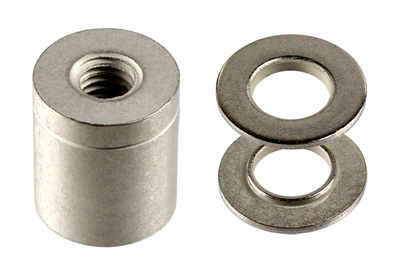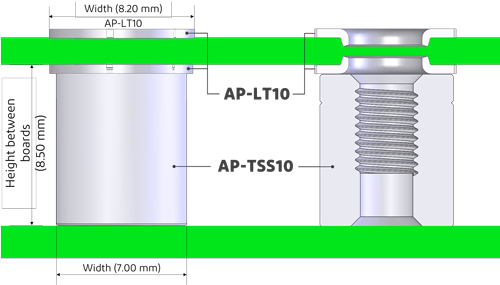I-PEX Inc. (Head Office: Kyoto City, Kyoto Prefecture; Representative Director, President and Executive Officer: Takaharu Tsuchiyama; TSE Prime Market Code No.: 6640; hereinafter referred to as “I-PEX”) has developed two new products in the AP series, board-to-board power terminals for in-vehicle chargers, inverters, and converters: the AP-TSS10 power terminal and spacer for high-current and high-temperature environments, and the AP-LT10 lug terminal*.
- ﹡Lug terminal: A power terminal, mounted onto a board, used to solder and connect leads to components with screw-type terminals
 AP-TSS10 (left), AP-LT10 (right)
AP-TSS10 (left), AP-LT10 (right)The AP-TSS10 and AP-LT10 has been on sale from late November 2023.
Development background
In recent years, the automotive industry has been steadily shifting from gasoline and diesel vehicles, which are mainly powered by fossil fuels, to EVs (electric vehicles). EVs require more space to store large-capacity batteries to extend vehicle cruising range.
The AP Series is a series of small board-to-board power terminals compatible with high currents and developed for key EV components such as in-vehicle chargers, inverters, and converters. It contributes to smaller in-vehicle chargers with higher outputs and larger battery capacities.
Features of the AP-TSS10 and AP-LT10
The two products were developed by changing the material and structure of the AP-10, the first product in the AP Series , and are compatible with higher currents (32 A) and higher temperatures (125 ℃) environments.
The AP-TSS10 is mounted onto the/a board using SMT*, while the AP-LT10 is mounted by reflow* soldering onto the surface and bottom of the through-hole of the other board . The final board-to-board connection is made by tightening the screws from above after both terminals are mounted. Using the AP-TSS10 and AP-LT10 reduces damage to the boards during the screw connection.
- ﹡SMT: SMT (Surface Mount Technology), a technique used to mount electronic components onto the surface of a printed circuit board
- ﹡Reflow: A soldering method in which a cream-like solder is printed in advance where the parts are to be mounted before the parts are mounted and welded
 Image of AP-TSS10 and AP-LT10 in use
Image of AP-TSS10 and AP-LT10 in useAs in-vehicle applications are becoming smaller and more sophisticated, boards have become denser, and it has become more common to mount components on both sides of boards. When mounting components on both sides, reflow soldering is done once in the front and in the back of the board to secure components. As the board is flipped during the second reflow, the solder may melt leading heavy components to drop due to their own weight or causing mounting defects The AP-TSS10 uses aluminum as its base material and is about 67% lighter than conventional metal spacers that use brass. This enables stable mounting on the back. The AP-TSS10 contributes to a better flexibility in board design and denser boards.
 Comparison of exisitng product and AP-TSS10 when double-sided mounting
Comparison of exisitng product and AP-TSS10 when double-sided mountingSpecifications
| Mating type | |
|---|---|
| Material | |
| Plating | |
| Base mounting method | |
| Height between connector mounting | |
| Width | |
| Rated temperature (energized) | |
| Rated current | |
| Contact resistance (board included) | |
| Tightening torque (recommended) | |
| Packaging format |
The AP-TSS10 and AP-LT10 can be used independently, but must be verified based on the detailed specifications of the customer's devices.




